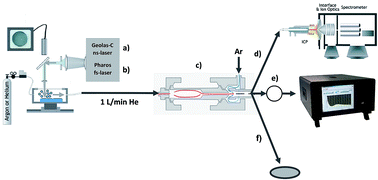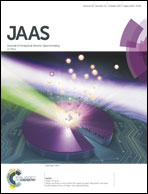A comparison of signal suppression and particle size distributions for ns- and fs-LA of metallic samples by LA-ETV-ICPMS†
Abstract
The influence of thermal treatment of laser-generated aerosols in a graphite furnace electrothermal vaporization (ETV) unit was investigated. Changes in the chemical composition and particle size distribution (PSD) of aerosols generated by nanosecond (ns-LA) and femtosecond (fs-LA) ablation of Cu, Zn, brass and Ta were monitored as a function of the graphite furnace temperature via inductively coupled plasma mass spectrometry (ICPMS) and with an optical particle counter (OPC). Morphology changes were investigated by recording SEM images of filter-collected material. With increasing furnace temperature, the ICPMS signals of all elements decreased and the onset temperatures of the suppression followed the order of the boiling points of the elements. Ablation with fs-LA generally showed a continuous signal decrease with increasing temperature. When ablating Zn with ns-LA, a discontinuity was introduced in the suppression profile, which was related to the PSDs of the original aerosols. Between 60 nm and 1 μm, they were generally broader when using fs-LA for the ablation of Zn, Cu and brass. When heating the aerosols, the morphology and PSD of the aerosols indicated that melting causes the nanoparticles' agglomerate to collapse into lumps of spherical shape. The discontinuity in the suppression profiles is interpreted to originate from the contribution of the large particles that do not evaporate and give a continuous contribution to the ion signals. Heating of the Ta-aerosols only resulted in a slight signal suppression, while SEM images revealed the presence of particles of larger sizes that were most likely formed from molten NPs and agglomerates. The thermal treatment opens a unique way for selective removal of elements forming spectral interference when using LA-ICPMS for spatially resolved solid sampling. In this study, the Zn-signal from the brass sample could be lowered by selective evaporation by more than 3 orders of magnitude, while Cu was still quantitatively retained in the aerosol. This separation was slightly more efficient when using fs-LA, which is most likely the result of the larger fraction of μm-sized particles in the ns-LA aerosols studied here.



 Please wait while we load your content...
Please wait while we load your content...